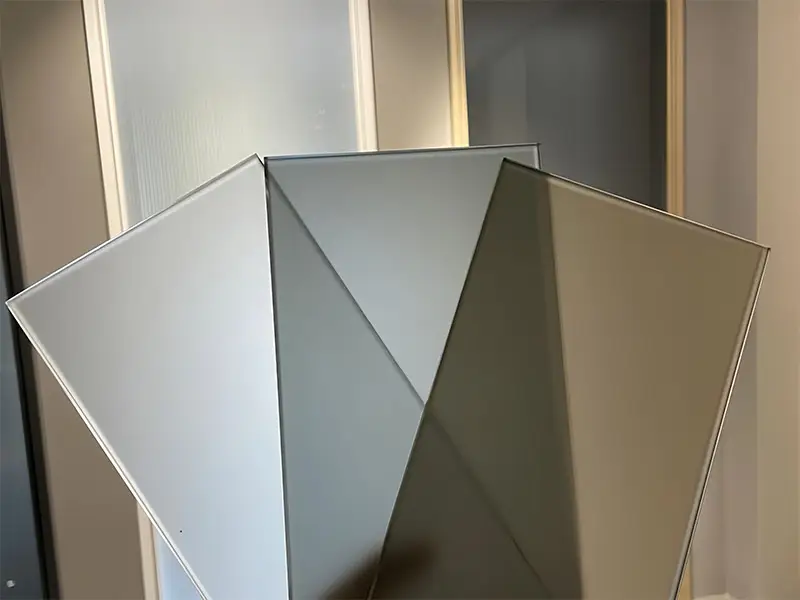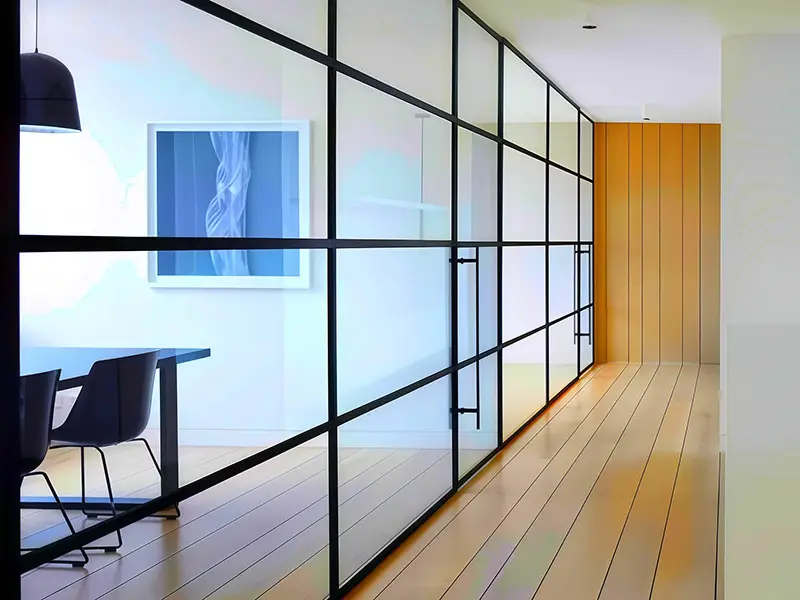







Frosted glass achieves a translucent yet opaque visual effect by using sandblasting, acid etching, or frosting processes to create a uniform fogging effect on the glass surface. It is widely used in doors, windows, partitions, and bathrooms, balancing light transmission with privacy protection. It's a preferred material for modern minimalist styles and functional decoration.
I. Core Feature Comparison
| Features | Frosted Glass | Jade Sand Glass | Oil Sand Glass |
| Process | Physical sandblasting/grinding (rough surface) | Chemical frosting (double-sided fine processing) | Chemical frosting (with shiny particles) |
| Surface Feel | Rough, easy to accumulate dust | Smooth and delicate, like jade | Obvious granular feel, smooth and shiny |
| Water Resistance | Turns transparent when wet (privacy compromised) | Remains opaque when wet | Slightly transparent when wet |
| Light Transmittance | Low (approximately 70%) | Medium-high (hazy fog effect) | High (with gloss scattering) |
| Cleaning Difficulty | Difficult to clean (rough surface traps dirt) | Easy to get fingerprints | Easy to clean (smooth and stain-resistant) |
II. Recommended Application Scenarios
1. Frosted Glass
• Applicable scenarios: Low-cost partitions, office doors and windows (where high privacy is not required);
• Taboos: Humid environments (bathroom doors lose effectiveness when wet), high-frequency contact areas (easily stained).
2. Jade Sand Glass
• Core advantages: Strong privacy protection (double-sided fog effect), high-end feel;
• Applicable scenarios: High-end bathroom partitions, entrance screens, hotel decorative walls;
• Drawbacks: Prone to fingerprints with prolonged use.
3. Oil Sand Glass
• Core advantages: Water and stain resistant, shiny particles enhance decorativeness;
• Applicable scenarios: Kitchen walls, shower rooms, commercial spaces (combining light transmission and cleanliness);
• Performance highlights: Light transmittance >85% and moderate privacy.
Scene Matching:
• Ultimate privacy + texture → Jade sand glass (e.g., bathroom);
• Easy to clean + light luxury → Oil sand glass (e.g., kitchen countertop);
• Limited budget + low requirements → Frosted glass (warehouse partition).
III. Purchasing Notes
1. Inspection Methods
• Jade sand glass: Water drop test (water droplets do not spread, indicating leak-proofness);
• Oil sand glass: Observe the uniformity of particles under light;
• Frosted glass: Check for surface scratches (affecting strength).
2. Pitfalls to Avoid
• Reject single-sided frosting (becomes transparent when wet);
• Oil sand glass should be checked for irritating odors (poor-quality coatings contain benzene);
• Large partitions should prioritize tempered laminated glass (increased impact resistance).
IV. New Composite Solutions
• Changhong Jade Sand Glass: Vertical stripes + jade sand frosted surface (increased light transmittance + privacy);
• Oil sand coated glass: UV-blocking coating (blocking rate ≥99%), suitable for sunroom roofs;
• Heated Jade Sand Glass: Built-in heating wire (anti-fogging in cold regions).
▶ Note: Architectural glass must comply with GB/T 38784-2020 pressure resistance standards, and commercial applications require a load test report.








Oil, jade, frosted glass
Category:
GLASS ENCYCLOPEDIA
Can frosted glass be cleaned with wet wipes?
→ Okay! Recommend using glass cleaner and fish scale cloth to avoid scratching the matte layer with hard objects.
How to choose between single-sided frosted and double-sided frosted?
→Single sided frosted (smooth surface facing inward) is easier to clean; Double sided frosted provides stronger privacy.
Will frosted glass reduce light transmittance?
→ It will decrease by about 20% -40%, and the ultra white glass substrate can reduce the loss of light transmission.
What are the common glass products in daily life?
Get A Quote
We will contact you within one working day. Please pay attention to your email.
Related Products









